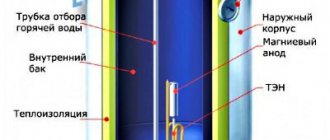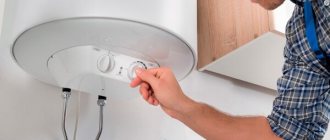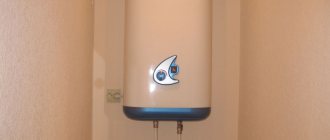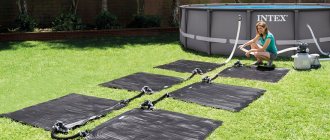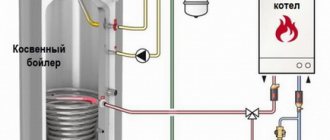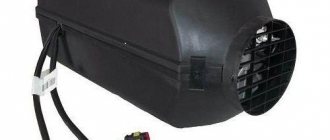Boiler advantages
Hot water in the house is not a luxury at all, but a necessary condition for comfort. However, residents of city apartments often face the fact that during the summer, hot water is disconnected from the centralized supply for repair work. This forces many people to install boilers - containers that allow water to be heated and used in the local water supply.
The advantage of heaters of this type is that they can be installed in almost any, even the smallest room. Modern models consume little electricity, which saves the family budget. And the most important plus is that there will always be a supply of hot water in the house.
Such devices are quite simple to operate, but if used irregularly, you may forget how to turn on the boiler correctly. The scheme is the same for most models. And provided that a certain sequence of all actions is followed, the water heater will serve its owner for a long time. You can turn it on yourself if you have instructions, or you can seek help from a specialist.
Calculation of annual operating costs
For calculations, you will need information about the energy efficiency class, type and cost of the coolant. Further calculations are performed using the formula:
- for gas models, the number of days per year is multiplied by energy efficiency and the cost of a cubic meter of gas;
- for electric boilers, the number of days per year is multiplied by energy efficiency and the cost of kW/hour.
Interesting to know! The DOE test for water heaters takes into account cold (15 degrees) and hot (60 degrees) temperatures and determines the unit's performance for a family of 3 as 240 liters per day.
Heating element power as a saving factor
The greater the power of the heating element, the faster the water will heat up. Keep in mind that in houses with a single-phase wiring diagram, from 7 to 10 kW of power are allocated. A high-performance water heater will lead to increased load on the network, huge energy costs and tripping of circuit breakers.
How to use a boiler economically?
You need to save with the water heater turned on during its operation, and not choose the most budget model. Users give a lot of advice on how to really save energy consumption on a household boiler.
Reducing hot water consumption
Is it just about energy resources? You will not understand how to use a household boiler economically if you do not calculate your water consumption. To increase the temperature of 1 liter of water, 0.001 kW/h of heater power is needed. But it’s easy to save money on this too.
Turning on the heater according to schedule
To save money, many families who use water in the morning for washing and in the evening for other procedures and cooking use a simple method: they turn off the unit before leaving for work and turn it on when they return home. This strategy justifies itself when the tank capacity does not exceed 50 liters - the device heats up within 1-1.5 hours.
It makes no sense to turn off 80 and 100 liter water heaters for the whole day. Firstly, after cooling, they take a long time to heat up, and secondly, they consume more energy than was saved. Hence the conclusion: it is better to set a large boiler to the minimum temperature and leave it in standby mode. When an increase in water consumption is expected, turn the regulator to maximum and in about an hour you will receive the required amount of hot water.

This is what a simple mechanical timer looks like - a socket. Price – no more than 10 USD. e.
Advice. There is an option suitable for units of any capacity. Buy a simple timer that will turn on the heating twice a day at a given time. By the way, more expensive water heaters already have a programming function for working according to a schedule.
Shower heads
Users who have studied how best to save wasted energy on a household boiler are advised to choose the right shower heads. They consume 10 liters of water per minute and are:
- classic, creating a water trail;
- with a soft jet, suitable for rooms with high humidity.
Outdated nozzles that consume about 20 liters of water per minute need to be replaced. First you need to time the time it takes to fill a three-liter jar. If it exceeds 20 seconds, buy a new nozzle.
Preheating
As mentioned above, in winter, water in centralized networks is often cooled to 10, or even 6 °C. It is clear that much more electricity must be spent to heat it. To reduce consumption, you can preheat water using other sources whose heat is cheaper. Here are some options:

A unit that heats water from two sources - a heating element and a copper coil
- Initially, purchase a boiler designed to connect to two energy sources - electricity and hot water from another source, for example, a wood or gas boiler. Such a device, shown in the photo, is equipped with a spiral water heat exchanger.
- Preheat 50-100 liters of water in an iron tank to room temperature, placing such a storage tank in the hottest room - the boiler room of a private house. In 8-10 hours, while you and your household are at work, the container will naturally warm up by 10 °C.
- Finally, use solar collectors - both factory-made and home-made. The method works well in the summer; if desired, you can place an additional tank outside, as described in the following video:
Reference. Home craftsmen from the southern regions have long adapted to making solar collectors from black polyethylene pipes placed in the yard or on the roof of the house. Thanks to this, the water heater actually does not work and does not “wind up” the electric meter.
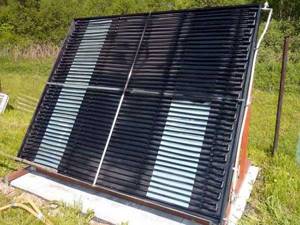
Homemade solar collector from black polyethylene pipes
Aerators and water flow limiters
Aerators are made in the form of a special nozzle. A kitchen element consumes 8 liters of water per minute, and one intended for a bathroom consumes from 5 to 15 liters per minute. If you install a flow limiter, you can spend no more than 40-75% of hot water, or 3 liters per minute.
Interesting to know! A minimum of 100 liters of water is spent to set up a bathroom, and no more than 30 liters for a 5-minute shower.
Replacing and connecting a thermostat for a boiler
If the water heater does not work, it should not be restarted. If it does not start, it means the unit is not working! And you shouldn’t expect it to suddenly turn on; you need to check for problems. If it is determined that the problem lies in the thermostat, it must be replaced. The main thing is the ability to choose the right device and install it correctly .
Both online resources and consultants in a store or market will help you figure this out. To replace the thermostat, you must perform the following manipulations:
- disconnect the boiler from the power supply;
- shut off the water supply to the tank with a special valve;
- drain all the water that is there from the tank;
- remove the bottom panel of the device, this will allow you to get to the heating element;
- remove the pressure ring located on the heating element;
- remove the sensor in the thermostat and the control unit;
- install a new regulator;
- return the pressure ring to the heating element;
- Replace the bottom panel of the device.
To purchase the necessary new thermostat for your boiler, you must follow the recommendations of experts . When going to a retail outlet to buy a regulator, you need to take with you the technical passport of the device. With it, it will be much easier for the sales consultant to figure out which model and with what characteristics you should choose.
When purchasing a thermostat yourself, you must remember that it must be the same model as it was before. Even the smallest difference can lead to failure of the entire water heater. You need to buy a thermostat taking into account the type of product, parameters, installation methods, what operating current and functionality it has.
Energy efficient operation of water heaters
To avoid overpayments for utilities, you need to figure out how to properly and effectively use a household boiler to rationally save water and electricity. There are several ways.
Waste water heat recovery
Between 80 and 90% of hot water's energy is lost to the drain. Installing the system allows you to use the heat of the waste liquid to heat the cold one. In apartments and houses it is advisable to use 2 types of equipment:
- with buffer capacity. Justified when using a washing machine or dishwasher. The effluent passes through a spiral tube in the tank, and its heat warms the water, which is pushed upward. The water returns to the boiler in a preheated state;
- without buffer capacity. A copper heat exchanger in the form of a spiral is wound onto the sewer sections. Preheated water also returns through it.
Important! Depending on the intensity of use, the payback period for such equipment is 2.5-7 years.
Heat traps
When the heater pipes are connected from above, the water rises and always heats the pipes.
Convection loops conduct heat into the air where it is wasted. Installing anti-convection channels at the points where the pipeline connects to the heater will increase the energy efficiency of the boiler. Heat traps can be made by tying vertical pipes horizontally. To prevent heat transfer, plastic inserts are made at the junction of the pipes and heaters.
Reducing the water temperature in the water heater
There is a program switch on the outer panel. By setting mode E (economical), you will heat the water to 55-60 degrees. The savings consist of increasing the resource of the heating element without wasting energy.
On the LCD panel, the Eco mode can be programmed to turn on at the desired time. For mechanically controlled boilers, just turn the handle.
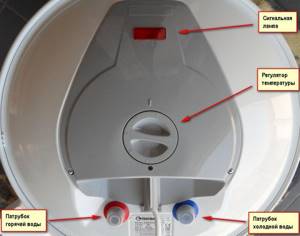
Location of control mechanisms
Savings in boiler operation ensure a reduction in utility bills. There are many ways to improve the energy efficiency of an appliance. When choosing a specific option, be guided by the type of water heater and its displacement.
Connection points – non-pressure and pressure versions of the flow-through heater
Based on the method of connection to the water main, instantaneous water heaters are divided into two groups.
Non-pressure water heaters
Heating systems of this group are not connected directly to the mains. They are designed to serve only one water distribution point. Water enters the non-pressure device through an already installed tap or mixer. Such a heater is not subject to main water pressure, and the pressure in it does not exceed atmospheric pressure. At the outlet, the gravity heater is equipped with its own swivel spout or shower hose, or a combination of both nozzles.
Various versions of such devices are available:
- A separate heater housing that mounts next to the sink or shower faucet.

Gravity water heater with a combination of tap and shower hose at the outlet
- In the form of a heating nozzle attached to the faucet. Disadvantage: the considerable size of this nozzle does not allow its use on low taps.
- A faucet with a heater already built into its body.

Faucet with built-in electric heater
As a rule, non-pressure models have a small power (3–7 kW), which is enough to provide hot water to one distribution point. You can install a pressureless connection to two different taps or mixers, as shown in the diagram.
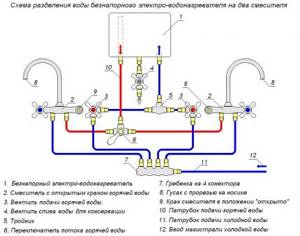
Connection diagram of a non-pressure flow-through heater to two points
But using a non-pressure device in this way is unlikely to provide sufficient heating when both mixers are operating simultaneously - there will not be enough power. And when working alternately, the scheme is quite viable.
For the heater to operate, it must be connected to the electrical network. Low power consumption does not require special connection circuits with protective devices. It is enough to plug it into a standard home electrical outlet. Modern models of pressureless water heaters are equipped with safety valves that turn off the heating when the water pressure drops.
The ease of connecting non-pressure water heaters and their low power allows them to be used as temporary devices during periods of hot water outages or in places of temporary residence. Their use is justified in one or two connection points in summer cottages - at the kitchen sink and in the summer shower. If constant heating of water is required throughout the year, it is better to use a pressure option.
Pressure instantaneous water heaters
Heaters of this type are capable of heating water for several outlets, which is enough to fully provide hot water to an apartment or an entire country house. Essentially, it is a small heating system, which is why pressure water heaters are sometimes called system heaters.
The pressure device cuts into the main water supply line - into the cold water riser in houses with a central water supply or after the pumping station in country houses with their own water supply.
All filters that ensure water purity must be connected before water enters the pressure heater. After leaving the heater, water supply is distributed to all points of consumption. The heating is turned on only when water is consumed - according to a signal from a sensor that responds to the water flow. It takes 1–2 minutes for the system to reach the required heating mode.
If a pressure system is installed in a house where there is already a hot water supply, to protect against it in case of its absence, then the connection diagram should ensure quick switching from one source of hot water to another.
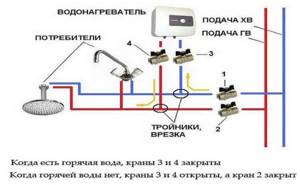
Scheme of a flow-through pressure system that allows you to switch the source of hot water supply from central to internal
Simultaneous heating of water for several points of consumption requires the appropriate power of the heating elements. For a single-phase electrical network with a voltage of 220 V, pressure heads are available with a power of up to 12 kW. The operation of more powerful systems (up to 25 kW) requires a three-phase voltage of 380 V. The connection of such devices must be carried out by specialists.
But even to connect a powerful device in a single-phase network, it is necessary to provide overload protection. It is advisable to use a residual current device (RCD) and an additional circuit breaker that controls the phase line.
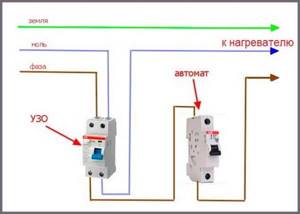
Electrical connection diagram for a instantaneous water heater in a single-phase network
In addition to protection, you also need appropriate electrical wiring that can withstand the current consumed by a powerful flow-through heater. As a rule, it is necessary to install a separate power supply line to operate the flow system. In houses where electric stoves are already installed, you can use their power line as a last resort. But in this case, the operation of the electric stove and water heater is possible only separately.
Operating instructions for water heater Garanterm GTR, GTN, GTI
Operating instructions for water heater Garanterm GTR, GTN, GTI
Accessories for water heater
Heating elements for water heater
| Heating element model | photo |
| Stainless steel heating element RF TW 2000W with M4 anode mount |
Anodes for water heater
| Anode model | photo |
| Magnesium anode M4 for water heaters |

SAFETY INSTRUCTIONS
• All plumbing and electrical work on installation, commissioning, repair and maintenance of the water heater must be carried out by qualified specialists with mandatory marks in the sections “Installation Mark” and “Warranty Card”. • Plumbing connections and shut-off valves must comply with the parameters of the water supply network and have the necessary quality certificates. • The water heater must be installed in a room where room temperature is maintained. • In order to avoid causing harm to the property of the consumer and (or) third parties in the event of malfunctions in the main water supply system, it is necessary to install the water heater in rooms with waterproofing of floors and drainage into the sewer. Under no circumstances should objects exposed to water be placed under the water heater. Otherwise, it is necessary to install a protective pan under the water heater with drainage into the sewer. It is necessary to follow the following rules when installing and operating the water heater: • do not operate the water heater without grounding; • do not operate the water heater without a safety valve; • do not connect the water heater to the electrical network if it is not filled with water; • do not drain water from the water heater if it is connected to the electrical network; • do not carry out service work with the water heater connected to the electrical network; • do not service the water heater using spare parts not recommended by the water heater manufacturer; • protect the water heater from the ingress of mechanical impurities present in the water by installing standard household cleaning filters; • do not use water from the water heater for cooking. TECHNICAL CHARACTERISTICS • The Garanterm water heater belongs to the category of closed-type water heaters and is designed to provide hot water to various premises with one or more water points, having a cold water supply line with a working pressure of at least 0.05 MPa and no more than 0.6 MPa. • The water heater has an internal tank made of high-quality stainless steel containing titanium, which ensures high corrosion resistance and, as a result, long service life. • Silver models in their design contain an electronic device with a silver anode, which ensures disinfection of heated water. This series of water heaters represents a “new generation” product that takes care of your health. • Regulation of the water heating temperature in the water heater within the range from 30°C to 75°C is carried out using a temperature regulator located on the body of the water heater. • The water heater has control lamps for light indication of operation. • The water heater has three water heating power modes: 0.7 kW, 1.3 kW, 2.0 kW, which provide, if necessary, both economical and forced heating of water. • ALL INCLUSIVE package (delivery includes: electrical cord, GT Valve type safety valve, mounting anchors, instruction manual). • Power supply parameters: single-phase network voltage 220V±10% and frequency 50Hz±1% • Protection class: IP 24 • Thread diameter of cold and hot water connection pipes: 1/2″ • The volume of the internal tank and the power of the heating element are indicated on the identification plate on the body of the water heater. INSTALLATION AND CONNECTION • MOUNTING To mount the water heater on a vertical surface, use the anchors included with the water heater. In this case, the surface on which it will be installed must support the weight of the water heater filled with water. • INSTALLATION It is recommended to install the water heater as close as possible to the place where hot water is used to reduce heat loss in the pipes. To ensure the possibility of maintenance, the water heater must be installed in such a way that the distance from the part on which the cold/hot water pipes are located to the nearest surface is at least 0.5 meters. The water heater installation diagram is shown in Fig. 1. • WATER HEATER INSTALLATION DIAGRAM The water heater is fastened using fastening strips A and B located on the body of the water heater and mounting anchors included in the delivery set. Rice. 1
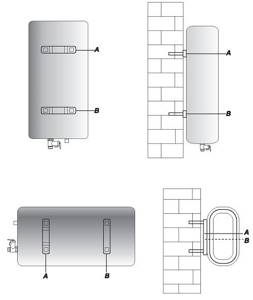
• CONNECTION TO THE WATER MAIN
Connection to the water supply is made in accordance with the diagram shown in Fig. 2.
Rice. 2
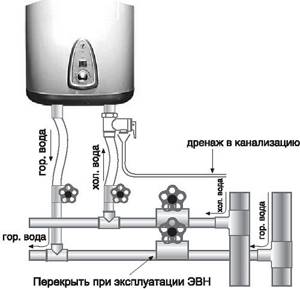
The safety valve included with the water heater must be installed on the cold water supply pipe of the water heater. Cold water must be supplied to the water heater through a standard household water purification filter (for example, a mud filter) installed in the line in front of the safety valve to avoid contamination of both the internal tank of the water heater and the safety valve. Contamination of the safety valve can lead to its failure, which in turn can lead to disruption of the normal operation of the water heater. When the water heater is operating, water may leak from the relief valve outlet pipe to relieve excess pressure, allowing the water heater to operate safely. This outlet pipe must remain open to the atmosphere and be installed permanently downward and in a frost-free environment.
It is necessary to ensure that water is drained from the outlet pipe of the safety valve into the sewer system.
It is necessary to regularly drain a small amount of water through the outlet pipe of the safety valve into the sewer system to remove limescale deposits and to check the functionality of the valve. To open the valve, it is equipped with a handle. It is necessary that during operation of the water heater this handle is in the position that closes the drain of water from the tank.
For ease of draining water, when carrying out maintenance of the water heater, it is recommended to install a drain valve (not included in the delivery package) between the cold water pipe and the safety valve.
When installing a water heater in places that are not supplied with a water main, it is allowed to supply water to it from an auxiliary tank located at a height of at least 5 meters from the top point of the water heater, or using a pumping station.
If the pressure in the water main exceeds 0.6 MPa, then an appropriate pressure reducing valve must be installed at the inlet in front of the safety valve (not included in the delivery package).
• CONNECTION TO ELECTRICAL NETWORK
Before connecting the water heater to the electrical network, make sure that its parameters (voltage, frequency, maximum electrical load) correspond to those for which the water heater is designed. Before connecting the water heater to the electrical network, the tank must be filled with water in accordance with the “Operation and Maintenance” section of this manual.
The water heater is equipped with a standard electrical cord with a plug that has a grounding contact. The electrical outlet must also have a grounding contact with a ground wire connected to it. The outlet must be located in a place protected from moisture or meet the requirements for moisture and splash resistance. OPERATION AND MAINTENANCE
• WATER HEATER OPERATION
After connecting to the water supply line, open the cold water supply valve to the water heater and the hot water tap on the mixer to ensure the outflow of air from the water heater. When the water heater tank is full, water will flow from the faucet. Insert the electrical cord of the water heater into the outlet and select one of three modes of water heating by pressing the switch keys on the body: key I corresponds to a power of 0.7 kW, key II corresponds to a power of 1.3 kW, both switched on keys correspond to the forced heating mode at power 2 .0 kW. When the key is turned on, it is illuminated by a light indicator, indicating that the water in the tank is being heated. During operation, the body of the water heater may heat up slightly. The temperature of the heated water is adjusted using the thermostat knob located on the body of the water heater. After the water temperature in the tank reaches the value set by the temperature regulator, the automation device will turn off the heating. When the temperature of the water in the tank drops, the automation device will turn on the heating of the water, thus maintaining its temperature at the set value. The average time required to heat the water in the tank to a temperature of 60°C with a cold water inlet temperature of 15°C, depending on the volume of the water heater in liters, is shown in Table 1.
Table 1. Water heating time
| Water heater volume in liters | Average water heating time in forced mode |
| 30 | 0 hour 50 min |
| 50 | 1 hour 20 min |
| 80 | 2 hours 10 min |
| 100 | 2 hours 40 min |
| 120 | 3 hours 10 min |
| 150 | 4 hours 00 min |
• MAINTENANCE
Maintenance is carried out to check for the presence and remove, if necessary, scale on the heating element. This also removes any sediment that may have formed at the bottom of the tank. Scale formed on the heating element can be removed using special cleaning agents or mechanically. It is recommended that a year after the start of operation of the water heater, the first maintenance is carried out by specialists from an authorized service center and, based on the intensity of scale and sediment formation, the timing of subsequent maintenance is determined.
Regular maintenance will maximize the life of your water heater. Lime buildup on the heating element can damage it.
Damage to the heating element due to scale formation on it is not covered by the manufacturer's warranty. Regular maintenance is not covered by the manufacturer's warranty.
In Silver models, it is necessary to replace the silver anode once a year by a specialized service center.
When carrying out maintenance yourself, you must follow safety precautions and carry out work in the following sequence. Using the switches on the body, turn off the water heater, then unplug the electrical cord from the outlet.
To avoid being scalded by hot water when draining it from the tank, you need to open the hot water tap of the mixer and wait for cold water to flow out of it, and leave it open. After this, turn off the valve to the flow of cold water into the tank. Turn the handle on the safety valve to drain the water from the tank into the sewer. Then, by removing the water heater cover from the side where the cold/hot water pipes are located, you need to disconnect the electrical wires connected to the contacts of the heating element. Carefully remove the capillary tube of the thermostat (automation device) from the protective tube located on the base of the heating element. Unscrew the bolts and remove the flange that secures the heating element. After removing the heating element, carefully clean it from scale (if necessary), and if there is sediment in the tank, also carefully remove it. After completing the service, reassemble the water heater in the reverse order, ensuring that the electrical wires are connected correctly to the contacts of the heating element. Put the water heater into operation in accordance with the instructions in this manual.
The activation of the thermal protection of the water heater does not indicate its malfunction. The water heater is returned to operating condition by pressing the thermal protection button. DISPOSAL If the rules for installation, operation and maintenance of the EWH are observed and the quality of the water used meets the current standards, the manufacturer sets a service life for it from the date of purchase of the EWH. All components of the water heater are made of materials that allow, if necessary, environmentally safe disposal, which must occur in accordance with the rules and regulations of the country where the water heater is operated. The manufacturer reserves the right to make changes to the design and characteristics of the water heater without prior notice.
Instructions for water heaters
How to use the boiler?
After the unit has gone through the first start-up procedure, you need to let it warm up the water to the maximum temperature. Open the tap on the mixer and make sure that hot water flows from there, and then carefully inspect everything for leaks. If everything is in order, then you can start using it. The first thing you need to do in order to use the boiler correctly is to study the manufacturer’s instructions.
Turn on the unit and set the desired hot water temperature. On most heaters, manufacturers provide 3 positions: 35, 55-57 and 75 ºС. Some models also have a fourth position – “anti-freeze”, then the temperature in the tank is maintained at 10 ºС. The actual operation is to set the temperature regulator to the desired position and use water. In this case, it is worth following these recommendations:
- never turn on the boiler if for some reason the unit’s tank is empty, this can lead to failure of the heating element. The inlet safety valve has a built-in check valve; its performance must be checked at least once a year;
- Although the boiler temperature is adjusted according to your wishes, you need to turn it on to maximum once every 2 weeks and maintain this mode for 2 hours. This is necessary so that harmful bacteria living in warm water do not multiply in the tank;
- There should be a strainer at the cold water inlet into the house. If the water is hard, then it is necessary to organize additional cleaning and desalting, otherwise all heating equipment, including the boiler, will not last long;
- Once every 2 years, clean the tank from scale, and also check the condition of the protective magnesium anode and, if necessary, change it.
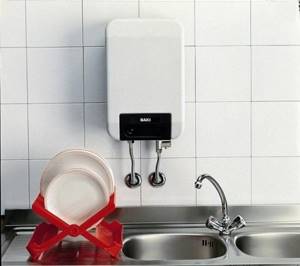
Using an electric instantaneous water heater is also quite simple. The device turns on immediately after opening the tap, the water temperature is regulated by decreasing and increasing the pressure. When the water runs too hot, the pressure must be increased; if it is cold, then decrease. For these devices, water hardness is also important; the presence of a large amount of salts will cause scale inside the heating element. First, the heating intensity will drop, and then the element will fail.
Features of operation of flow models

Differences in different types of devices determine the operating characteristics. Before starting use, you need to study the instructions from the manufacturer and perform the following steps:
- Install a coarse filter. It will allow you to collect small debris that comes from water pipes.
- Carry out horizontal installation. Only this type of installation is allowed so that there are no air pockets. The check is carried out using a building level.
- If the device is electrical, it must be grounded.
Flow models come with manual and electronic control. The first option is reliable and low cost. Electronic mechanisms are more expensive, but they expand functionality.
Before turning on the flow-through heater for the first time, it is necessary to set the optimal water temperature. It can be adjusted by buttons or by the tap itself, depending on the fluid flow. These types of water heaters can only be used at positive temperatures.
The device should be inspected periodically for damage. It is prohibited to use a faulty heater. If the device is no longer needed to heat water, it must be removed from the wall, after first unplugging it from the network and removing any remaining water. The water heater should be stored in a warm room in winter.
Features of operation of storage boilers

Storage boiler device with heating element
Models with a water tank vary in size. Larger units are usually wall-mounted or floor-mounted. There are vertical and horizontal types.
Only a device that is correctly configured and connected to the network can be turned on and used. The work must be carried out by a specialist. He also marks the quality of equipment installation.
After installation, you can use the boiler. Before the first start-up, you need to visually inspect it and ensure the integrity of the housing and wires. After a successful test, you need to fill the tank with water. To do this, open the water supply valve.
When the tank is full, you can plug in the device and press the power button. Control is carried out using buttons on the body or by entering commands on the monitor.
If the boiler is the main source of water, there is no need to disconnect it from the network. A thermostat should be installed so that the heater only operates when necessary. When the set temperature is reached, the device will automatically turn off.
Water heater maintenance
The list of maintenance work is not too lengthy:
- replacing the magnesium anode;
- descaling;
- checking the inlet check valve.
Replacing the magnesium anode
This element prevents scale crystallization on the walls of the tank and heating element. The magnesium anode gradually dissolves, so it is recommended to replace it with a new one approximately once a year.
Note! Some manufacturers remove the boiler from warranty service if its magnesium anode is not changed in a timely manner. If you purchased a water heater from such a manufacturer, do not forget to mark the anode replacement on the appropriate form, or at least keep the receipts if you buy it yourself.
It should be noted that many boiler service technicians, in private conversations or in discussions on thematic forums, give the following advice: as long as the water heater is working normally, there is no need to disassemble it or change anything. There are cases where boilers worked properly for 10 years or more without any intervention - it all depends on the amount of salts in the water, that is, its hardness.

If the boiler is expensive and under warranty, it is better to change the anode with the help of service specialists
If the device has clearly become worse at heating water, and when the heater is operating, a hissing or crackling sound is heard inside, it means that the layer of scale has developed a significant thickness and it is really time to change the magnesium anode. At the same time, the tank and heating element must be carefully cleaned of salt deposits.
Those whose tap water has increased hardness are advised to take measures to soften it. There are two ways:
- Install a softening filter with a cartridge filled with ion exchange resin in front of the boiler. This substance replaces calcium and magnesium ions with harmless sodium. It is better to choose filters that can be regenerated (restored) at home.
- Installation of a hydromagnetic system (HMS). This device is non-volatile. It is equipped with a permanent magnet, the field of which causes crystallization of hardness salts, as a result of which they turn from solution into sludge - a suspension of small particles. The sludge is retained by a fine filter installed after the magnet.
The simplest way to remove scale and deposits can be seen in the video.
How to clean a boiler-type water heater (video)
Checking the serviceability of the check valve at the boiler inlet
This procedure is recommended to be performed annually. Here's what to do:
- Turn off the valve that disconnects the boiler from the cold water line.
- Shut off the root valve, which cuts off the internal cold water distribution from the riser.
- Open the cold water tap on any of the faucets. All these steps will allow you to check the root valve for leaks: if water does not drip from the tap, then everything is fine with it and you can start checking the check valve.
- Open the valve that shuts off the boiler from the hot water supply.
Open both taps on the mixer (air will enter the system through the open hot water tap). If the check valve is leaking water, it will drip from the faucet.
Checking the health of the equipment
In order to check how well the water heating device works after a break in operation, it is necessary to record the initial temperature readings on the device and compare them with the temperature 15-20 minutes after switching on. If the temperature rises, it means the water is heating up and the boiler is working properly.
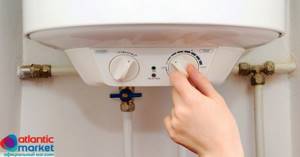
Important! Since the water heating device has high power, a separate RCD should be installed on the boiler.
After turning on the water heating equipment, you also need to check the pipes for leaks. They happen due to the fact that the gaskets in the pipes do not always withstand the water pressure in the water heater, which is usually an order of magnitude higher than in the riser.
If, when you turn on water heating equipment that has not been in use for a long time, your plugs are knocked out, try starting again. Re-disabling the automatic starter requires consultation with a specialist.
How to use a Termex water heater: general instructions for EWH
However, despite the design differences, the order of their inclusion has the same principle. The universal instructions for starting a Termex boiler are as follows:
- Before turning on the water heater, the shut-off valve for supplying hot liquid from the common riser is closed. This occurs even if a check valve is installed on the pipe. After all, if there is a slight malfunction, the device will heat the central water supply without blocking the channel.
- Before connecting the Termex storage water heater to the network, it is filled with water. The outlet of the hot liquid device and the mixer open in turn, and after them the inlet of the cold flow. These manipulations are necessary to displace air from the system.
- After the water has flowed in an even stream, you can turn it off, turn on the unit to the power grid and, after setting the settings and waiting an hour or two, start using it.
The connection diagram for a Thermex water heater when using flow-type devices will be similar, except that the result will be felt immediately.
The next stage after switching on is checking the functionality. Before using the Thermex water heater you need to:
- Make sure that the power indicators light up when plugged in.
- Measure the temperature of the liquid supplied to the mixer.
- After 20 minutes, look at the equipment sensors; if the connection of the boiler with the touch panel is done correctly, the temperature indicator on the device should already increase. If there is no electronic panel, you must once again measure the degree of heating of the water at the outlet of the mixer.
What to do if Thermex does not turn on
The installation process of a Thermex instantaneous water heater or any other model requires the presence of serviceable network elements: sockets, circuit breakers, cables of sufficient thickness. The devices have very high power, so if they do not work, first of all, armed with a tester, you need to check the presence of electricity in the outlet, then the power terminals. Video instructions for installing a Termex water heater will help you find their location, and the tester will help you take readings. If the voltage is zero, then the cable of the electrical appliance is broken.
What to do if the Thermex water heater does not turn on, or rather, power is supplied, but it gives an error - the most popular question. In this case, you need to open the device instructions and look at the explanation corresponding to the code indicated on the display. If this option is not available, the causes of the problem may be the following:
The heating element has a damaged or burnt-out coil. A sign is often a breakdown of electricity on the housing, then the RCD automatically trips and cuts off the power supply. The only way to combat this is by replacing the heating element. The protection is triggered if the heating of the coolant rises above the set limit (usually more than 90 degrees), which occurs both when the control thermostat breaks down and when scale accumulates on the heating element, after which it overheats. The tank is not filled with water. How to turn on a Thermex ID 50V boiler or another model for the first time was discussed above, and if the requirements for removing air from the pipes are not met, a protective mechanism is triggered
Please note that this must be done even if the system is full but has not been used for a long time.
Any owner of such a water heating device knows how to use a boiler. But only a lucky few know how to save on electricity bills without breaking the law. After reading this article, you will be one of them, learning how to save on hot water supply.
In the modern world it is difficult to do without a water heater in an apartment
Trial run
Boiler installations are often carried out by professionals. They are the ones who should carry out a test run immediately after installation. But if you installed everything yourself, then be sure to do the following.
- Make sure that the water heater is installed efficiently, according to its instructions.
- Inspect it for leaks. Fill with water after disconnecting from the power supply.
- To see when the tank is full, open the hot water valve. If water flows, the tank is already full.
- Close the valve and examine the outside of the device.

Second boiler connection diagram
Only after this can you safely connect the boiler to the power supply and set it to the desired temperature.
Note! Often, when operating a boiler, human intervention is not required. This is a completely autonomous device, although in some cases you still have to set the minimum settings and adjust them. Such settings are individual for each model, so be sure to read the instructions .
Installation methods
Installation of water heaters is very simple. It can be performed by anyone with due diligence and instructions. Each device comes complete with fasteners and everything necessary to connect the boiler to the water supply and electrical networks.
Types of fastenings
There are several types of water heater mountings. Each owner chooses a suitable model based on the characteristics of the place where the device will be installed:
- Horizontal is an excellent option for installing a boiler above a sink in a kitchen or bathroom. It is usually used in apartment buildings where saving space is a top priority.
- Vertical is the classic way to install boilers. It is used in private homes to save square meters in the boiler room or in apartments. Narrow water heaters located in small niches or in the corner of the room are the most economical option for placing equipment.
Some devices can be installed both vertically and horizontally.
Connection
Connecting to a single source is a simple and inefficient way to use a water heater. The 50 liter model is capable of providing water to several sources.
Self-installation:
- Using the included mounts, the equipment is installed on the wall at a distance of 30 cm from the ceiling.
- The cold water supply pipe is equipped with a safety valve.
- Water is removed from the boiler. To do this, you need to open the water supply and drain valve.
- The water heater is connected to the electrical network using a special connector; if necessary, the owners can extend the wire themselves.
After completion of the work, all connections must be additionally sealed.
First launch of a boiler from different manufacturers
Depending on the brand, connection details may vary.
Ariston (Ariston)
As soon as the water has collected and you have connected to the network, do this:
- Make sure the indicators on the panel light up.
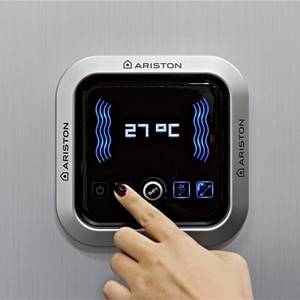
- After this, the temperature lights should blink. This means that the boiler is not working.
- On the panel, press the power key.
- Based on the readings on the display (in the current state), set the required heating temperature using the thermostat or keys.
- Press the power button to select a mode from 1500 to 2500 W.
If your model does not have “memory” installed, after disconnecting it you will have to set the settings again.
Thermex (Termex)
The device from this manufacturer has simple controls. After connecting to the network, just turn the thermostat to the desired position and heating will begin. After 30 minutes, you can check how the temperature is rising on the sensor. Open the mixer - is there a hot stream? So you did everything right.
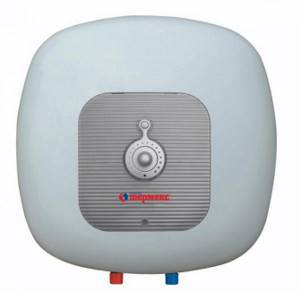
Electrolux (Electrolux)
To turn on water heating, press the Power button. Set the necessary indicators. You can read more about how to use the water heater in the instructions.

Standard instructions for an Ariston water heater 80 liters
Water heaters of this size are necessary for daily use by the whole family. The presence of sensors and temperature levels guarantees safe operation.
For long-term use of the device, it is necessary to carry out installation in accordance with all the rules or with the help of an experienced technician. To avoid breakdowns and other hassles, follow the operating rules:
- The first switching on and off should be carried out with a full tank.
- If the batteries are damaged, be sure to replace the weak parts.
- In a room with sub-zero temperatures, it is necessary to drain the water from the heater.
- Leaving the device idle for a long time without a heating function should be done with the water supply tap or valve closed. Heaters must also be unplugged from the outlet.
Devices for high-quality water heating from Ariston are presented in user-friendly sizes, equipped with all kinds of engineering improvements and are available in all major retail chains. All you need to do is select the model you need for individual installation.
Review of the Ariston Velis PW 50 Water Heater - video
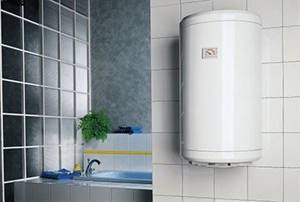
For city residents, at least once a year there comes a period when “an apartment with all the amenities” turns into an “apartment with inconveniences.”
The reason for this metamorphosis is the preventive shutdown of hot water supply. Even in hot weather, the absence of this “good of civilization” causes significant discomfort, and even if this happened in the cold season...
Not wanting to waste time on tedious running around with buckets and saucepans, many resort to a very simple solution - install a boiler. In this article we will learn how to use a water heater, get acquainted with popular brands and talk about their maintenance.
Operation of an already operating boiler
It is worth noting that during operation the device should never be disconnected from the network. This can only be done in cases where hot water is not needed for some time. At the same time, experienced people say: if hot water is constantly present in the boiler, it will be less susceptible to corrosion. And setting the required temperature is much easier than heating water from scratch.
You may be interested in information on how to choose a water heater
If the tap water has increased hardness, then it is advisable to install a filter in front of the boiler. If you install the device in places with high humidity (bathhouse, sauna, etc.), carefully ensure that droplets of water do not fall on it.
Flow-through boilers differ from storage boilers in the absence of any restrictions on the amount of hot water. Such devices are often installed in only one place (in which they take a shower or wash dishes). But note that when the tap is fully opened, the water simply will not have time to heat up. To reduce heat loss, it is advisable to install the water heater as close as possible to the point of water use.
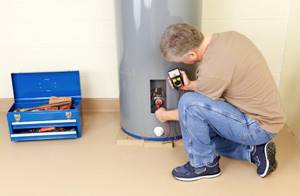
Prevention of a flow-through boiler
Note! The use of instantaneous boilers is strictly prohibited in rooms where the temperature can drop to zero degrees.
Basic rules for using a water heater
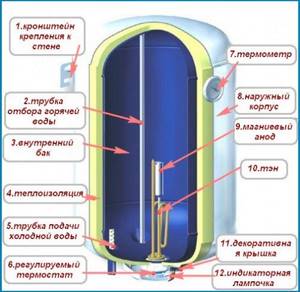
Diagram of an electric water heater.
- The device must be installed before use. The service life of the unit largely depends on correct installation. During installation, follow the instructions supplied with the device. If grounding is required, it must be done. In order for the device to work for a long time, it is not recommended to turn it off and on frequently. If hot water is needed every day, then you should not disconnect the device from the network. With frequent switching on and off, the automation can quickly fail.
- Before turning on the boiler, you should close the hot water riser through which it is supplied to the apartment. After this, you can open two taps on the water heater and turn on the power. In order to turn it off, you need to do everything the other way around. If there is no hot water supply to the apartment, then there is no need to close anything. When bathing unnecessarily, do not turn on the hot water frequently.
- If you are leaving for a long time, the boiler must be disconnected from the network. After a year of using the device, preventive maintenance should be carried out. The higher the water temperature is set, the more it needs to be diluted. If there is only one person living in the apartment, you can immediately set the required temperature so that there is no need to dilute the water later. This will save money. If a large number of people live, then you should set the maximum temperature so that there is enough water for everyone.
Related article: Plasterboard ceiling: design of kitchen, corridor
Do I need to drain the water?
Usually the remaining water in the boiler is not drained. It remains in the water heater until the next time it is turned on, provided that the period of inactivity is short. If you turn off the boiler for several weeks or months, the water must be drained. Otherwise, oxidation or scale formation may occur, which will shorten the service life of water heating equipment.

It is necessary to drain the water after the boiler is disconnected from the power supply in poorly heated housing. In a home with low temperatures, water can freeze and rupture the water heater. To eliminate any remaining water, you should use a check valve. It is located on the equipment body.
Thermostat for water heater
The thermostat ensures safe operation of the water heater.
This process is explained as follows: when the water temperature rises, the pressure inside the tank, which is sealed, increases. When the increase in pressure is not controlled, the entire structure will explode , which is dangerous not only for equipment and surrounding objects, but also for human health if a person is nearby during the explosion.
The thermostat allows you to maintain the temperature at the required level. Bottom line: the temperature regulator protects against explosion, overheating , damage to equipment and property, and ensures the safety of people.
Most manufacturers try to equip the boiler with a thermostat, because it is he who controls the heating of water at the moment when the device is connected, and for the timely blocking of the heating element.
a wide range of models on the market , but they all operate on the same principle. At the moment when you need to connect the device to the network, you need to immediately adjust the water heating level, which is done using the control panel, which is located on the body.
Next you need to adjust the water heating. The relay that is installed on the thermostat will be responsible for opening the contacts of the heating element. When the tank has completely cooled down, the temperature will drop and become lower than normal. At this moment the contacts of the heating element of the relay will close , due to which the system will start again and the liquid in the tank will begin to heat up again.
Turning on the water heater without water
Many users are concerned about what to do if they turn on the boiler without water. If you forget to fill the boiler tank with water when you turn it on, it will not turn off automatically. The temperature sensor will detect the air temperature in the room (20-25 degrees), take this indicator as the water temperature and will not recognize errors. What will happen? The most unpleasant consequence of the lack of water in the water heater can be the burnout of the heating element. If such a breakdown occurs, it is unlikely to be repaired even under warranty.

What is a boiler
A storage electric water heater is a device that gives its users independence from the general heating system. In fact, it is like a large thermos, which ensures long-term storage of the specified water temperature. All this happens thanks to the thermal insulation layer, however, there are other important components in the design of the unit:
- heating element (most often heating element);
- thermostat to regulate water temperature;
- the container itself is in the form of a steel tank (enamel coated on the inside).
It is the tank that determines the cost of the device. If all other parts can be easily replaced, then if the tank leaks, it would be best to buy a new boiler.
Care and maintenance features

Periodically it is necessary to clean the heating element from scale
To ensure trouble-free operation of the heater, you must follow the following rules:
- Carry out timely care and maintenance. The models are undemanding, so it is enough to wipe them from dust and dirt with a sponge without detergents.
- Study the operating conditions and comply with them.
By following the instructions from the manufacturer, you can protect the device from failure.
Some equipment should only be installed, started up and maintained by a specialist. The master performs all this work and puts a mark on the warranty card. Otherwise, the user will not receive warranty service and repairs.
If a storage boiler is used, work is carried out annually to clean the heating element from scale, the tank from sediment, and the condition of the magnesium anode is assessed. The check is carried out with the boiler turned off from the network. If it is not used for a long time, you need to drain the water from the tank.
Common thermostat problems
Any device, even the most reliable and expensive, fails over time, which is facilitated by many different factors, both internal and external. Breakdowns that require close attention:
- Wear of copper tube.
- There is a violation in the relationship between the three-pin thermostat and the heater.
- Heating element regulation failure.
- Formation of limescale.
- Voltage fluctuations can cause damage.
If you do not have knowledge and skills in working with thermostats and connecting them, then it is better to entrust this issue to specialists . This will, on the one hand, relieve you of unnecessary doubts and worries, and on the other hand, ensure the correct operation of the unit and the safety of others.
Thermostat for a boiler - thermostat: temperature adjustment, types
Source
Possible problems and their solutions
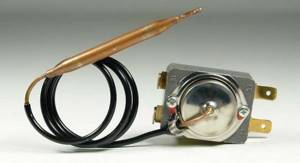
Changes in water temperature may be caused by a broken thermostat
During the operation of boilers, certain problems may arise. Usually this is an unpleasant odor and mold. They may appear when the heating temperature is set to 40°C. Setting such values is beneficial from the point of view of energy savings, but it is precisely in such conditions that bacteria and fungi actively multiply. To eliminate the problem, it is necessary to set the temperature at 50-55°C. Each model has its own meaning called eco mode.
When operating the device, do not connect to a hot water pipeline. The device may malfunction. Average temperature values depend on the type of model.
When warm water stops flowing out of the instantaneous heater, pressure problems can be judged. Some devices have a low pressure mixer installed. If it is selected incorrectly, the water is turned off. To resume fluid supply, the pressure should be normalized. The reason may be that the water supply is cut off. It needs to be renewed.
The water coming from the tap may be too hot. This is due to incorrect temperature control settings. If the device has a manual adjustment mechanism, you need to set the optimal values yourself. To set up electronic models, you need to call a technician.
Any changes in water temperature may be due to a broken thermostat. To replace it, you need to call a specialist.
Sources
- https://FB.ru/article/320340/kak-vklyuchit-boyler-vodonagrevatel-poryadok-deystviy
- https://tehnikoved.ru/klimaticheskaya-tehnika/vodonagrevatel/kak-ekonomit-elektrichestvo-na-bojlere.html
- https://otivent.com/kak-polzovatsja-bojlerom
- https://TechnoSova.ru/klimaticheskaja-tehnika/vodonagrevatel/chto-takoe-protochnyj-vodonagrevatel-kak-on-rabotaet/
- https://cotlix.com/kak-polzovatsya-bojlerom
- https://StrojDvor.ru/otoplenie/instrukciya-po-pravilnomu-vklyucheniyu-vodonagrevatelya/
- https://atlantic-market.com.ua/kak-pravilno-vklyuchat-i-vyklyuchat-boyler-posledovatelnost-deystviy
- https://kanalizaciyaseptik.ru/bojlery/kak-polzovatsya-bojlerom.html
- https://cosmo-frost.ru/bojlery-i-vodonagrevateli/ekspluataciya/kak-pravilno-vklyuchit-zapustit-bojler-v-pervyj-raz/
Sequencing
It’s worth mentioning right away that the startup sequence below is correct for both flow-through and storage heaters . A couple of nuances - in the case of the first type, you do not have to wait for the tank to be filled with water and close the tap at the 2nd point.
- You should start by turning off the hot water supply , which comes from the city supply system. If you skip this step, the water heated by the boiler will go into the common riser, despite the check valve.
- Open the hot water tap . We wait until the remaining liquid drains from the pipes. Close the tap.
- Two pipes go to the bottom of the boiler. One, marked with a blue ring, is underwater, the other, with a red marker, serves to supply hot water to the pipes .
- Open the valve on the underwater pipe . Water begins to flow into the device’s storage tank.
- Next, unscrew the second valve on the boiler . Allowing the water to escape into the pipes.
- Open hot water on the mixer . We wait until the air leaves the system and a steady stream of water flows. We turn off the water.
- We connect the heater to the electrical network and set the desired temperature.
Heating mode selection
Set the heating mode. The main thing in this matter is to set the water temperature that is comfortable for the user . However, here are a few tips, the implementation of which will significantly extend the service life of the device. This will save you money on future repairs.
- Set the temperature to 30–40 degrees as little as possible . Under such conditions, bacteria will quickly develop inside the storage tank. This will result in an unpleasant musty odor. The walls will become covered with fungus, which is difficult to remove.
- Optimal operating mode, 55–60 degrees . In this temperature range, less scale will form on the heating element. The risk of mold will be reduced. It is comfortable for human skin.
- Once a week the boiler must be set to 90 degrees . Wait a couple of hours and return to the previous mode. This is done to completely destroy bacteria in the storage tank.
- Some devices have an economical operating mode. In this case, the heater does not consume less electricity. The settings will be set as in point 2 and we are talking about reducing the risk of breakdown.
- In the case of a flow-type heater, the temperature is also adjusted by water pressure.
